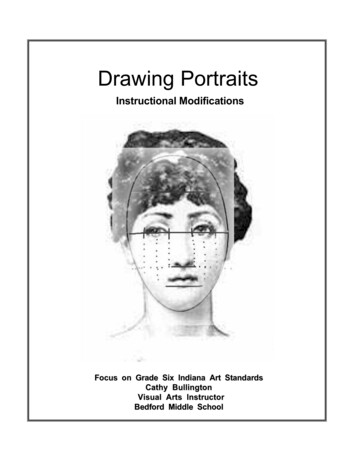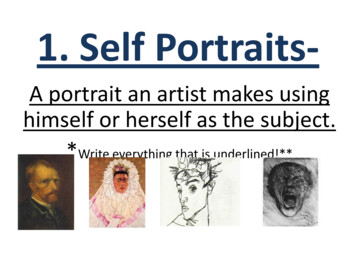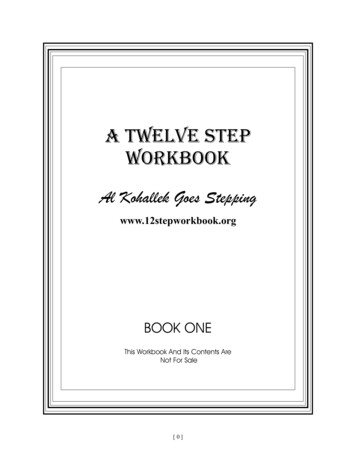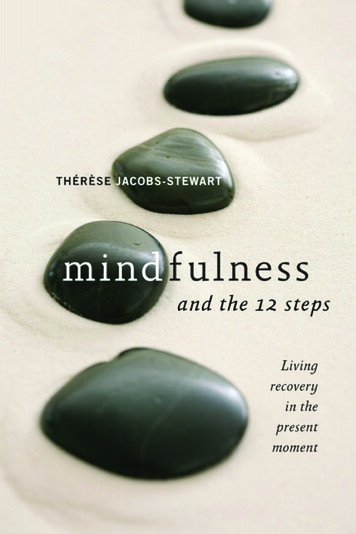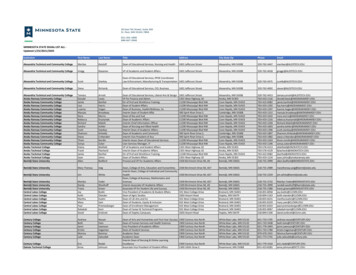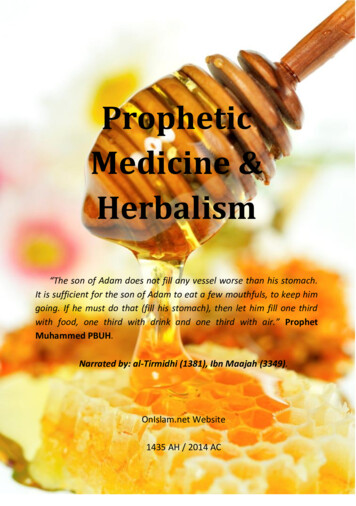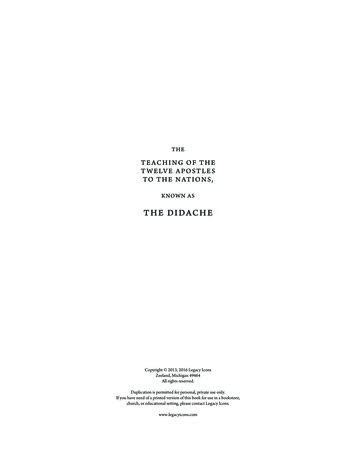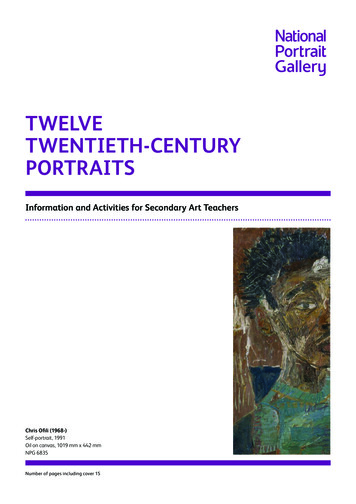
Transcription
TWELVETWENTIETH-CENTURYPORTRAITSInformation and Activities for Secondary Art TeachersChris Ofili (1968-)Self-portrait, 1991Oil on canvas, 1019 mm x 442 mmNPG 6835Number of pages including cover 15
2 /15Information and Activities for Secondary Art TeachersTwelve Twentieth-Century portraitsNew InfluencesThe invention of photography in the mid-nineteenth century, affected themarket for representational portraits. Artists began to experiment with newstyles, techniques and fashions in painting. The French Impressionists were the firstto break the mould, and were followed by pioneers of abstraction such as Malevich,Mondrian and Kandinsky. British artists were slow to pick up on the new trends butgradually, thanks to artists such as James McNeill Whistler, Roger Fry and PercyWyndham Lewis, avant-garde approaches began to filter across from continentalEurope. The National Portrait Gallery is especially rich in works by artists of theBloomsbury Group as well as owning works by many well-known portraitists whohave been instrumental in changing and developing the genre.Individual StyleUnlike portraits painted in other centuries, those produced in the twentieth centurytend to be painted wholly by each individual artist whereas in the seventeenth tonineteenth centuries collaborations were common. Twentieth-century works tendto reflect more of an artist’s individual stylistic achievement. Due to the pervasiveinfluence of the photographic portrait, the twentieth-century painted portraitdeveloped a slightly different brief. Artists have gone down a multitude of roadsto try to resolve the problem of creating a likeness whilst retaining their artisticintegrity. Naturally ‘pot-boilers’ still exist, as do works that obviously flatter sitters,works that merely document a sitter’s prestige and of course portraits that simplyreiterate the photographic through technical prowess.The portraits which merit our consideration here are those which provoke in theviewer a dual insight: firstly gaining knowledge of the sitter’s appearance andpersonality, and secondly a feeling of the painterly mood and style of the artist.The ultimate goal is to blend the two successfully. However, our response issubjective and so opinions will differ as to the success of the following works.Teachers’ Notes Twelve Twentieth-Century portraitsNational Portrait Gallery
3 /15Information and Activities for Secondary Art TeachersTwelve Twentieth-Century portraitsAugustus John (1878-1961)William Orpen (1878-1931),exhibited 1900Oil on canvas, 991 x 940 mmNPG 4252This painting by William Orpen of the artist Augustus John,straddles the turn of the century. It is a classic mixture ofold and new, and consciously based on Whistler’s portraitof Thomas Carlyle (1872-3, Arrangement in Grey and Black,No 2. Glasgow Museum and Art Gallery). John and Orpenwere friends, having trained together at the Slade, and bothbelonged to the New English Art Club.John, a lively, romantic and flamboyant artist is posed in arelaxed but controlled manner, sitting on an ordinary woodenchair. Although indoors, as the background indicates, hewears a heavy outdoor coat and his hand rests elegantlyon his jaunty hat. The sombre background sets off the lightTeachers’ Notes Twelve Twentieth-Century portraitson his face and hands. The repeated verticals enclose therounded figure whose form and posture is echoed in theshapes of the wood making up the chair. The colour rangeis subdued, except for the bright red vertical band on theright-hand side. This contrast of red against the darknessof the remaining areas of the picture brings a balancingdynamic to the whole composition. John’s brooding,confident and determined look with his unruly hair andpointed beard create a visual foil with the vibrant red strip.Contrary to what one might expect, there is no formal signof John’s artistic status - no brushes, no palette, no studio.John is said to have disliked the portrait.National Portrait Gallery
4 /15Information and Activities for Secondary Art TeachersTwelve Twentieth-Century portraitsLytton Strachey (1880-1932)Simon Bussy (1870-1954), 1904Oil on canvas, 533 x 432 mmNPG 4595 reservedThis small pastel of Strachey shows him hard at work on abasic trestle table littered with books and papers. With penpoised and long fingers tensed over his manuscript, thisfamously long-legged artist and critic bends over his work.There is no doubt that he is a writer. Indeed, his work is in themiddle of the drawing (diagonal lines taken from each cornerwould meet almost at his black pen), emphasising the level ofhis concentration and coaxing us into the world of the picture.The colour mood is low key; dusty greys, taupe and mauvesblend with ochre and brown. The medium of pastel has anatmospheric quality. Two single clear and bright colours arrestTeachers’ Notes Twelve Twentieth-Century portraitsour gaze: his yellow tie and the delicate sky blue, orientaltype bowl on the shelf behind him. These, the direction of hisconcentrated bowed head and the white of the papers againpull our eyes to the centre of the drawing.Bussy was born in France. After studying (under Moreau)and exhibiting in Paris, he came to London in 1902. Hearrived with a letter of introduction to Lady Strachey, andthe next year married her daughter Dorothy, Lytton’s sister.From 1907 onwards he exhibited regularly in London andParis, including shows at the Goupil and Leicester galleries.He collaborated with Roger Fry in the Omega workshop.National Portrait Gallery
5 /15Information and Activities for Secondary Art TeachersTwelve Twentieth-Century portraitsHenri Gaudier-Brzeska (1891-1915)Self-portrait, 1912Pencil, 559 x 394 mmNPG 4814The French sculptor Gaudier-Brzeska was the son of acarpenter. A prolific draughtsman, drawing from life in orderto inform his sculpture, he is famous for his over life-sizestone carved hieratic head of Ezra Pound (1914). An admirerof Rodin and later influenced by Epstein, he was part of theangry anti-Bloomsbury group Blast. His death in the FirstWorld War, ended his brief but dazzling contributionto modernist sculpture.We can see that this is a sculptor’s drawing from the way theform and structure of the head and shoulders are mappedout with a view to later reproduction in three dimensions.Teachers’ Notes Twelve Twentieth-Century portraitsGaudier-Brzeska does this by organising his tonal areas inadvance, and then shading the pure linear study. The selfportrait is lively because we can sense the speed with whichhe has used the charcoal to make the intense blacks andsofter grey areas. The work is clear, elegant and refined.There is a purity about the roughness and simplicity of themedium combined with the confrontational stare of thesubject’s eyes. It has the feeling of a working drawing; thesculptor understanding the three-dimensional planes of thebody, and then rendering them into flatness with the illusionof a second dimension.National Portrait Gallery
6 /15Information and Activities for Secondary Art TeachersTwelve Twentieth-Century portraitsVanessa Bell (1879-1961)Duncan Grant (1885-1978), c. 1918Oil on canvas, 940 x 606 mmNPG 4331The artist Vanessa Bell was part of the Bloomsbury Groupalong with her sister Virginia Woolf, her husband Clive Belland her lover Duncan Grant, who painted this portrait. Itis therefore a special type of portrait - a personal, visualdocument made by one artist of another with whom he hasan intimate relationship. We see Vanessa Bell in a loose, red,paisley-patterned cotton frock, her hands loosely claspedtogether on her lap, holding a rose, with her wide-eyed gazeturned away from us. Grant uses green colours in the fleshtones, an Impressionist device to render skin more lifelike. Thedress is sleeveless, so that her uncovered arms make distinctiveshapes against the blue background, the colour of which isreminiscent of that used in early icons of the Madonna.Teachers’ Notes Twelve Twentieth-Century portraitsGrant’s painting style evolved from a deep admiration forthe Post-Impressionists and the Fauves, and one cansee echoes of these influences here. He studied at theWestminster School of Art (1902-5), then visited Italy, spenta year in Paris and then a term at the Slade. He showed sixworks in Roger Fry’s second Post-Impressionist exhibition, andalso worked for him at the Omega workshop. He collaboratedwith Vanessa Bell on a number of artistic schemes (oftendecorative) throughout his long and productive artistic career.Their daughter Angelica was born in 1918, the year that thisportrait was painted.National Portrait Gallery
7 /15Information and Activities for Secondary Art TeachersTwelve Twentieth-Century portraitsJoseph Conrad (1857-1924)Walter Tittle (1883-1966), 1923-4Oil on canvas, 851 x 699 mmNPG 2220Joseph Conrad was a writer, but here is shown withoutthe standard props of desk, pen and paper. Instead, heseems to be sitting in a chair looking into a bright lightagainst an almost surreal background of sea and sky. Hishands hang loose on the chair-rests and glow in sympathywith his brightly lit face which is characterised by his welltrimmed and pointed white beard. The sharp white of thehandkerchief, cuff, collar, and monocle, stand out againstthe sombre colour of his suit and waistcoat. Despite thesuit, there is a faint air of the old sea captain about him,reinforced by his determined look, the heavy-lidded eyes,strong nose and beard. This, combined with the backgroundTeachers’ Notes Twelve Twentieth-Century portraitsof billowing rain swept clouds, evokes some of the essenceof Conrad’s writing; the broadness of his imagination andthe mysterious depths of ‘Nostromo’ and ‘The Nigger ofthe ‘Narcissus’’, as well as the circumstances of his life.Tittle was an American artist who specialised in portraits ofBritish and American politicians and literary men. Particularlyfond of etching as a medium, he used dry-point to record thefeatures of President Roosevelt in 1942-3. He was also knownfor his illustrations and cartoons, contributing over manyyears to magazines such as ‘Life’ and ‘Harper’s’.National Portrait Gallery
8 /15Information and Activities for Secondary Art TeachersTwelve Twentieth-Century portraitsG. K. Chesterton (1874-1936),Maurice Baring (1874-1945) andHilaire Belloc (1870-1953)Sir James Gunn (1893-1964), 1932Oil on canvas, 1,511 x 1,105 mmNPG 3654This group portrait of three authors illustrates how an artistensures a balanced composition when dealing with thecomplex visual dynamics of a group. Gunn makes Baring’sbalding head the apex of a triangular structure; with theseated Chesterton and Belloc as the base. The white paperon the table is a simultaneous focal point for us and thesitters, reinforcing their complicity and concentration. Thepainting leaning against the wall behind them is visuallyuseful as its ‘L’ shape echoes that of the wall and the dadorail. All the sitters gaze downwards. We follow their gazeand notice details in the work: the reflections in the shinytable top; the pinstripes on Chesterton’s trousers repeat inthe table leg and finally the three areas of colour; wall, floorand sitters.Teachers’ Notes Twelve Twentieth-Century portraitsGunn said of the portrait; ‘. Mr Chesterton with his radiatinggeniality, his air of the witty philosopher, and the Invernesscloak that adds to his massive bulk, is of course an inspirationto any portrait painter. Then I found Belloc’s powerful andmasterful head a real intellectual exercise. In the HonourableMaurice Baring, I aimed at the suavity of the ex-diplomatand the man of the world, who has travelled, writtenextensively on Russia, cultivated the arts and made his placealso among the poets . I found all three excellent subjects.Of course, one expects that from such men, each of whom isan artist in his own sphere.’Gunn was born in Glasgow and studied both there, inEdinburgh and at the Academie Julian in Paris. In 1961 hewas made an RA.National Portrait Gallery
9 /15Information and Activities for Secondary Art TeachersTwelve Twentieth-Century portraitsDame Barbara Hepworth(1903-1975)Self-portrait, 1950Pencil on gesso on board,305 x 265 mmNPG 5919Barbara Hepworth was a sculptor, she joined the Sevenand Five Society in 1931, where her pioneering abstractionsparalleled the work of Henry Moore and Ben Nicholson(her second husband); she was especially known for hersubtle use of the ‘hole’.The board on which Hepworth draws has a thin coatingof gesso. Into this the artist has made brisk pencil marksindicating her hand holding the board on which she draws a classic method of self-portrayal. The surface texture is fullTeachers’ Notes Twelve Twentieth-Century portraitsof intentional scratches and dents giving the work a ruggedthree-dimensional quality. In places the white gesso is rubbeddown and an orange paint glows around the edges. Watermixed with the pencil on plaster produces a tone suggestingsoft shadow. A tint of brown ink darkens the colour of herhair, brush strokes give it direction, and these are enhancedby heavy swirling pencil. The eyes are clearly delineated andthere is a strong highlight to the nose. The whole is a vivid,confident drawing: lively, vigorous, relaxed and yet controlled.The portrait is signed on the lower left-hand side.National Portrait Gallery
10 /15Information and Activities for Secondary Art TeachersTwelve Twentieth-Century portraitsRalph Vaughan Williams (1872-1958)Gerald Kelly (1879-1972), 1958-61Oil on canvas, 1,067 x 889 mmNPG 4829This portrait shows a composer in an active role, baton inhand. Kelly’s picture is traditional in style and has visual linkswith the portrait of Monsieur Bertin by Ingres. Ralph VaughanWilliams is gesturing with his baton as if conducting; a musicscore is open before him on a table. The roundness of hisbody is contained within a round-backed chair, the arm ofwhich is decorated with a golden sphinx. The paintwork isprecise and delicate. The sitter’s unruly hair is rendered withdeft strokes of the brush, the left hand is foreshortenedskilfully, and the colours are subdued. Looking carefully, youwill notice that he is wearing a hearing aid. Rather thanignoring his deafness, Kelly has faithfully included this devicewhich adds poignancy to the portrait.Teachers’ Notes Twelve Twentieth-Century portraitsBorn in London in 1879, the son of a vicar, Kelly was educatedat Eton and then read English at Cambridge. Deciding tobe a painter he went to Paris where he met Renoir, Monet,Degas and Rodin through the art dealer Rurand-Ruel. Healso met Sickert, Sargent and Maugham who encouragedhim to travel to Burma. Pictures he painted there helped himto make his reputation on returning to England in 1909. Hebecame an associate RA in 1922, a full member in 1930 andsucceeded Munnings as President from 1949-54.National Portrait Gallery
11 /15Information and Activities for Secondary Art TeachersTwelve Twentieth-Century portraitsHer Majesty Queen Elizabeth II(B. 1926)Pietro Annigoni (1910-1988), 1969Oil on canvas, 1,981 x 1,778 mmNPG 4706Annigoni’s portrait of Elizabeth II provoked an uproar when itwas first exhibited in 1969. Since then, people have come toappreciate the stately quality it possesses. There is no specificbackground to this work. Annigoni indicates a sky and ahorizon and has his subject dressed in a regal cape, decoratedwith a minimum of honours. The Queen is portrayed withoutthe normal prerequisites of a royal portrait: the crown, sceptreand orb; nor does he employ the old-fashioned Van Dyckiandevice of showing her mounted on a horse. The resonance ofthe red cape against the blue background is strong and wecan appreciate colour parallels with the Grant portrait of Bell,although the latter is lighter in treatment. Annigoni employsthe full force of his experience to create a modern royalportrait which marries the human and the slightly surreal; thenormal woman with the unique inheritance of royalty. TheTeachers’ Notes Twelve Twentieth-Century portraitswork is large and imposing. The Queen dominates the canvasand her expression is cool and confident; a triangular figure,alone in an abstract open space, the solitude reinforcing herunique perspective.Annigoni was born in the suburbs of Milan in 1910. Hestudied at the Accademia Delle Belle Arti in Florence in thelate twenties and early thirties, becoming disenchanted with‘modern art’. He met a Russian artist, Lokoff, who shared hisoil-tempera techniques with Annigoni. By mixing oil paintwith secret quantities of egg yolk and wine, Annigoni learntto suggest the qualities of High Renaissance Old Masterpainting. In the late fifties his portrait work became soughtafter by high society. Other famous sitters included PopeJohn XXIII and President Kennedy.National Portrait Gallery
12 /15Information and Activities for Secondary Art TeachersTwelve Twentieth-Century portraitsDorothy Hodgkin (1910-1994)Maggi Hambling (b. 1945), 1985Oil on canvas, 932 x 760 mmNPG 5797Dorothy Hodgkin was a chemist and crystallographer. In1949 she published the three-dimensional structure ofpenicillin, and in 1964 she was awarded the Nobel Prizefor her work on the structure of Vitamin B12. In 1969 shediscovered the structure of insulin; a model of which wesee in the foreground of this portrait. Hodgkin is shown ather desk, her arthritic hands jumping. The four hands area convenient artistic invention visually suggestiong thescientist’s dynamism. Her desk is laden with papers, behindher the bookshelves are loaded with books and files and outof the window we can see into the back garden. The portraitprovides us with a view of the workaday surroundings ofTeachers’ Notes Twelve Twentieth-Century portraitssomeone who looks like a friendly grandmother, who is that,but is also someone who has achieved world status andrecognition within her field of research and discovery. It is thisjuxtaposition between the humble woolly blue cardigan andthe implication of the molecular structure of insulin whichgives this portrait a true resonance.Maggi Hambling was born in Suffolk and studied underLett-Haines and Cedric Morris at the East Anglian School ofPainting and Drawing (1960-2), then at Camberwell (1962-7)and finally at the Slade (1967-9). She was the first Artist inResidence at The National Gallery 1980-1.National Portrait Gallery
13 /15Information and Activities for Secondary Art TeachersTwelve Twentieth-Century portraitsStephen Hawking (B. 1942)Yolanda Sonnabend (b. 1935), 1985Oil on canvas, 912 x 710 mmNPG 5799Stephen Hawking is a mathematician and theoreticalphysicist who, since 1979, has been Lucasian Professorof Mathematics at Cambridge University. His main workis in the field of general relativity and in the theory andunderstanding of ‘black holes’.Yolanda Sonnabend’s arresting portrait of Hawking is astragic as it is beautiful. She makes a magical fusion betweenthis man’s handicap (he suffers from motor neuronedisease) and his genius. We see him in his wheelchair, lefthand grasping the controls. His angular face and body areemaciated; his suit a floppy sack. Behind, a blackboardoverflows with busy calculations; white hieroglyphics,spinning and rapidly revolving like graphic equivalents ofTeachers’ Notes Twelve Twentieth-Century portraitsthe stars he studies. His eyes appear luminous, sad andblank, his mouth a resolutely clenched smile. The portrait ispowerful and poignant, a moving interpretation of a brilliantbrain locked into a frail, decaying body. The artist uses oilloosely. Sometimes the surfaces of her paintings have analmost grubby look to them where they have picked updust and debris.Sonnabend was born in Zimbabwe and studied at theAcadémie des Beaux Arts, Geneva in 1951 and then atthe Slade from 1955-60. She regularly designs sets foropera, ballet, theatre and television, her most importantcollaborations being at Covent Garden with the late SirKenneth MacMillan.National Portrait Gallery
14 /15Information and Activities for Secondary Art TeachersTwelve Twentieth-Century portraitsChris Ofili (1968-)Self-portrait, 1991Oil on canvas, 1019 mm x 442 mmNPG 6835Born in Manchester, Chris Ofili studied at Chelsea Schoolof Art (1988-91) and Royal College of Art (1991-3). He wasincluded in the Whitworth Young Contemporaries (1989,1990 and 1991) and the NPG’s BP Portrait Award (1990and 1991). Also in 1991 he won a British Council TravelScholarship to Zimbabwe. Ofili uses collage and paint tocomment on ugliness, conventional beauty and identity withdiverse references to popular culture and African art. He isTeachers’ Notes Twelve Twentieth-Century portraitsfamous for using elephant dung as a support and decorationon his paintings. He was included in the Sensation exhibitionat the Royal Academy (1997) and won the Turner prize in1998. The purchase in 2005, by the Tate gallery of The UpperRoom, an installation of 13 paintings by Ofili in a speciallydesigned room caused controversy as the artist was on theboard of Tate trustees at the time of the purchase. Ofili nowresides in Trinidad.National Portrait Gallery
15 /15Information and Activities for Secondary Art TeachersTwelve Twentieth-Century portraitsActivityQuestionsThe following types of questions can be asked while viewing the images to stimulate discussion aboutthe portraits. As you consider each work, it is important to remember that you are looking at a digitalreproduction of an original artwork. The scale will generally be different, and neither texture nor colourwill be totally accurate:Why do you think that artists still choose to paint portraits when photography exists?What do you think that a portrait should show? Do you think that a commissioned portrait can be as successful as a portrait painted forits own sake, from artistic desire rather than for money?How much of the sitter do we see? Do you think that it matters if only part of the sitter (eg. head and shoulders) are portrayedas opposed to a full-length portrait?Can you tell what medium has been used? If you had the choice of commissioning a painting or a photograph of yourself, and moneywas no object, which medium would you choose?How old do you think the work is?How long do you think it took the artist to make?What is the scale of the original?What (if anything) is in the work in addition to the portrait?How is the sitter dressed?How is the figure lit? Where is the light coming from? What type of colours has the artist used? Does this give the portrait a particular kindof emotive quality?Is anything particular conveyed to us through the pose of the sitter? Is likeness important or do you think that it is sufficient for other aspects of a sitter’s personalityto be conveyed by means such as colour, scale and symbols?Does this make these emotive aspects more important than the purely physical ones?Teachers’ Notes Twelve Twentieth-Century portraitsNational Portrait Gallery
Teachers’ Notes Twelve Twentieth-Century portraits Information and Activities for Secondary Art Teachers 5 /15 National Portrait Gallery Henri Gaudier-Brzeska (1891-1915) Self-portrait, 1912 Pencil, 559 x 394 mm NPG 4814 The French sculptor Gaudier-Brzeska was the son of a carpenter. A prolific



